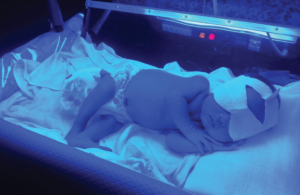Even after my third baby, I worried about jaundice. That beautiful baby skin I witnessed at birth would all of a sudden begin to shift to a yellowish color, making me question how “normal” this was. As any worried parent would do, I asked my pediatrician and low and behold, everything was normal. Despite the reassurance, I was still uneasy.
Jaundice occurs in 50 – 60 percent of full-term babies, says Nick DeBlasio, M.D., MEd medical director at Pediatric Primary Care Center, Cincinnati Children’s Hospital Medical Center. An even higher percentage occurs in premature babies, as well as babies born from East Asian or Mediterranean families, according to the Centers for Disease Control and Prevention.
Jaundice is at its highest peak about three-to-five days after your baby’s homecoming. So if family and friends come to visit and say, “It looks like he has a little jaundice,” brush it off and say it is normal and will work its way out on its own. But why does this weird yellowing occur in the first place?
“Jaundice occurs because of high levels of bilirubin in a baby’s blood,” says DeBlasio. “Bilirubin comes from the breakdown of old red blood cells and is removed from the blood by the liver and excreted from the body in the stool.”
While your little bundle is awaiting his grand arrival, all cozied up in Mom’s utero, Mom’s liver is working to remove the bilirubin. After birth, it takes a few days for a newborn’s liver to start removing bilirubin from the blood and high levels of bilirubin is what causes the yellow, jaundiced appearance in babies. Typically, it starts in the face and then spreads downward to the chest, abdomen, arms and legs.
BREASTFED VS. FORMULA-FED
If you’re breastfeeding, your pediatrician may tell you that jaundice will take a bit longer to work its way out, sometimes up to one month. In formula-fed babies, it typically goes away in about two weeks, DeBlasio says. Formula fed or breastfed, feeding your baby frequently and on demand will help to bring out the white in his eyes.
“The main thing that a parent can do to help is to make sure that the baby is feeding regularly,” says DeBlasio. “Bilirubin is excreted in the stool so every time a baby stools, he is excreting some bilirubin which helps with the jaundice level.”
It is not recommended to put your baby in sunlight to help decrease jaundice as this may lead to a sunburn.
HOW JAUNDICE IS TOO MUCH?
To ensure your baby’s jaundice levels are in check, (and overall health is good) you will see your pediatrician three-to-five days after birth (as long as there are no complications). High levels of bilirubin can potentially lead to health issues, but these can easily be prevented if jaundice is treated immediately. If your baby is born with high levels, a special treatment called phototherapy — exposure to ultraviolet light — will be done at the hospital to help break down the bilirubin. In some cases where levels of bilirubin are less high, this can be done at home.
Keep a look out if your baby has a worsening yellow color to the skin and eyes. If the yellow color continues to worsen or fails to improve, that is a sign that jaundice could be worsening and the baby should be seen by the pediatrician, says DeBlasio. Your pediatrician will examine your baby to check if additional testing or treatment is needed.
Newborn livers need some
time to get up and running
when it comes to getting rid
of bilirubin. Newborns also
have more red cells than older
children and adults, and those
brand-new red cells don’t last
as long as the ones that get
made as babies grow older.
The combination of these two
factors is what makes jaundice so common.






